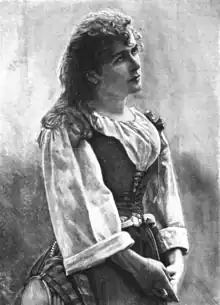Elisa Frandin
Elisa Frandin (7 April 1859[1] – 24 January 1911) was a Finnish-French opera singer.
Elisa Frandin | |
|---|---|
 Elisa Frandin as "Mignon", from a 1908 publication | |
| Born | Elisabeth Frandin 7 April 1859 Helsinki |
| Died | 24 January 1911 (aged 51) Milan |
| Other names | Lison Frandin, Elisabeta Combi |
| Occupation(s) | Opera singer, voice teacher |
Early life
Elisabeth Frandin was born in Helsinki, the daughter of Joseph-Hippolyte-Eugène Frandin and Pauline Lemagne. Her parents were French; her father was the French consul in Helsinki when she was born. Her older brother Joseph-Hippolyte Frandin (1852–1926), was a French diplomat in China, Korea, Colombia, and Ecuador.[2][3]
Elisa Frandin studied voice at the Conservatoire de Paris with Joseph-Théodore-Désiré Barbot and Louis-Henri Obin. She won several awards as a Conservatoire student.[4]
Career
Frandin, who sang soprano and mezzo-soprano parts, made her professional debut in Paris in 1881, in Grissart's Les Poupées de l'Infante. Frandin sang in operas in Cairo, Barcelona, Monte Carlo, Berlin, and many Italian cities. Her repertoire included roles in Lakmé by Delibes (1883),[5] Bizet's Carmen,[6] Verdi's Aida, Maillart's Les dragons de Villars, Auber's Le Domino Noir, Boito's Mefistofele, Mascagni's Cavalleria rusticana, Massenet's Werther and La Navarraise (1895–1896),[7][8] and Leoncavallo's La bohème (1897).[9][10] She and Marie van Zandt were the first to sing the well-known Flower Duet from Lakmé, in Paris in 1883.[11]
Frandin survived a train accident in 1893, but lost all her theatrical luggage, including costumes and jewelry; she was compensated with ₤500,000 by the railway company. She retired from the stage when she married in 1897, and opened a music school in Milan.[4][12]
Personal life
Frandin married Italian journalist Carlo Combi in 1897. They had a son, Mario Combi, born in 1898. She died in 1911, aged 51 years, in Milan.
References
- Some sources give an 1854 birthdate; her son's birth in 1898 makes the later date somewhat more likely.
- Vautier, Claire Vigneau, Mme Alfred; Frandin, Hippolyte (1905). En Corée, par Mme Claire Vautier et Hippolyte Frandin (in French). Paris: C. Delagrave. OCLC 458432562.
{{cite book}}: CS1 maint: multiple names: authors list (link) - "Hippolyte Frandin (1852–1926)". data.bnf.fr (in French). Retrieved 5 April 2021.
- "Lison Frandin's Operatic School". Musical Courier. 56: 14. 1 April 1908.
- Fuller, Nick (16 August 2018). "81. Lakmé (Léo Delibes)". The Opera Scribe. Archived from the original on 2020-09-24. Retrieved 5 April 2021.
- "Ricordi Artistici". L'Arpa Giornale Letterario, Artistico, Teatrale (in Italian). 34: 105–106. 18 December 1887.
- "In Italian Cities". The Theatre. 27: 172–173. 1 March 1896.
- "La Navarrese". Libretti d'opera (in Italian). Retrieved 5 April 2021.
- "La bohème (1897)". Libretti di opera (in Italian). Archived from the original on 2007-02-15. Retrieved 5 April 2021.
- Dryden, Konrad (3 February 2007). Leoncavallo: Life and Works. Scarecrow Press. pp. 36–37, 43, 70. ISBN 978-1-4617-1665-5.
- "Lakme : duettino". AU Digital Research Archive. Retrieved 5 April 2021.
- Leparello (5 January 1908). "La scuola di Lison Frandin". L'Illustrazione Popolare (in Italian): 15–16.
External links
- Manuscript letters by Lison Frandin, 1884–1885, from the Archivio Storico Ricordi, Collezione Digitale.